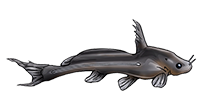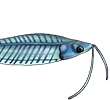/siluriformes/clariidae/channallabes/apus/1.jpg)
Eel Catfish, Lemmeløs ålemalle (Denmark) - Channallabes apus (Günther, 1873)
Article © Richard Broadbent, uploaded July 15, 2010.
Richard Broadbent introduces another fine African Catfish of the month - a slippery customer with bags of eel appeal!
The family Clariidae is nowhere near as popular as some other families of catfish, even those from Africa, but this species is a relatively problem free denizen for tanks of 36”and above. It is relatively unfussy as far as water conditions, accepts a wide range of foods, mixes well with other tank mates and has interesting habits.
It is available from time to time at a reasonable price and because of its appearance is not confused with much else: the exceptions being other Channallabes species and Gymnallabes (see CotM July 2005) which are very seldom imported. The difference from Gymnallabes being the absence of pectoral and ventral fins in Channallabes. It is a long slender eel-like species brown or brownish-grey in colour on the dorsal surface, lighter underneath which gets to a foot long.
In the wild this species is found in the Congo river system and eats a lot of small terrestrial insects. Well, so do a lot of other catfish but the unique habit here is that it leaves the water to hunt and feed on land, rather than simply feeding on insects that fall into the water. This is not witnessed in aquaria unless specific set-ups are created with some sort of terrestrial area but one thing to consider is having a completely closed tight fitting lid to prevent this catfish going “walkies” like its larger, better known relatives, Clarias. In captivity it can bury itself in deep sand substrates and appreciates gnarled roots and branches where it can conceal itself. It does not tolerate poor water conditions and can easily succumb to infections brought on by stress — in fact pictures in Seegers and Aqualog show an individual with a dusting of yellow spots which appears to be an infection and is not typical of an individual in good health. A good water change regime along with placid tankmates lead to a trouble free existence. Good tankmates are larger shoaling African tetras and peaceful medium sized African barbs.
It has not yet been bred in aquaria, but egg-filled individuals have been seen, so some dedicated enthusiast may well have some success if they put the effort in with a serious breeding project and find a key spawning trigger. So all-in-all perhaps not everyone's "cup of tea" but nevertheless an interesting and rewarding species.
Copyright information for the images used in this article can be found on the species' full Cat-eLog page.
| Scientific Name | Channallabes apus (Günther, 1873) |
| Common Names | Eel Catfish Lemmeløs ålemalle (Denmark) |
| Type Locality | Interior of Ambriz, Angola. |
| Synonym(s) | Clariallabes apus, Gymnallabes apus |
| Pronunciation | cha nal ah bez - ah pess |
| Etymology | Channallabes: From the Greek, channe, meaning anchovy and allabes, the name of a Nilotic fish (a kind of lamprey); in reference to the shape of the fish. From the Greek prefix a- meaning without and pous, meaning foot; in reference to the lack of pelvic fins. |
| Articles | |
| Size | 327mm or 12.9" SL. Find near, nearer or same sized spp. |
| Identification | Distinguished by the extremely elongate body, reduced cranial shield, confluent median fins, small eyes and absence of pelvic fins. |
| General Remarks | Recent research has documented this species' ability to feed terrestially (videos above). The catfish's neck is especially flexible, with specialized vertebrae that allow it to hold its head up out of the water without using fins. The fish's diet provided the scientists with the first clue to its remarkable behaviour - it mainly eats beetles which are found on land. The researchers speculate that a similar feeding strategy could have been used by the first vertebrates to emerge from the oceans. The fish is known to burrow into the substrate and has been caught by hook and line in waterlogged areas adjacent to rivers and swamps simply by digging a hole and fishing in the resulting pool. |
| Distribution | Africa: Angola to Congo River Basin. African Waters, Congo (click on these areas to find other species found there) Login to view the map. |
| IUCN Red List Category | Least Concern , range map and more is available on the IUCN species page. Last assessed 2009. |
| pH | 5.8 - 7.0 |
| Temperature | 22.0-27.0°C or 71.6-80.6°F (Show species within this range) |
| Other Parameters | Sensitive to bad water; this species appears particularly susceptible to bacterial / parasitic infections. |
| Feeding | Will take all manner of pelleted food, as well as frozen/live food (the latter being preferred). User data. |
| Furniture | Provide plenty of driftwood for the fish to hide. Ensure that the tank cover is tight-fitting/weighed down, they are capable of climbing out. |
| Compatibility | A peaceful fish that is best suited for the West African biotope tank. Ideal tankmates include mid-sized African barbs, tetras, and cichlids. |
| Breeding | Not reported. |
| Breeding Reports | There is no breeding report. |
| Reference | Annals and Magazine of Natural History (Series 4) v. 12 (no. 68) (art. 19), pp 142. |
| Registered Keepers | There are 15 registered keepers, view all "my cats" data. |
| Wishlists | Love this species? Click the heart to add it to your wish list. There are 7 wishes to keep this species, see who wants what. |
| Spotters | Spotted this species somewhere? Click the binoculars! There are 5 records of this fish being seen, view them all. |
| Forum BBCode | |
| Search for C. apus | |
| Look up C. apus on AquaticRepublic.com | |
 | Look up C. apus on Fishbase |
 | Look up C. apus on Encyclopedia of Life |
 | Look up C. apus on Global Biodiversity Information Facility |
| LFS label creator ARN ref:1.6.176.631 | |
| Last Update | 2020 Sep 19 05:14 (species record created: 2010 Jul 15 02:59) |
Back to Catfish of the Month index.




